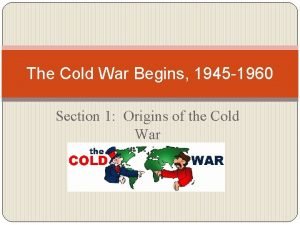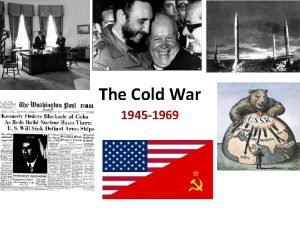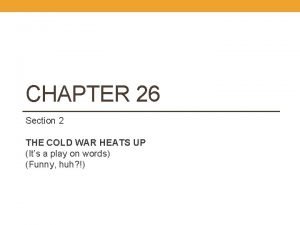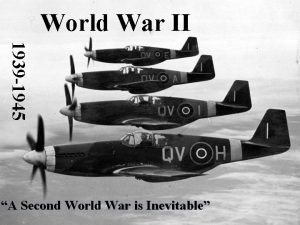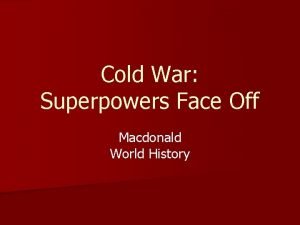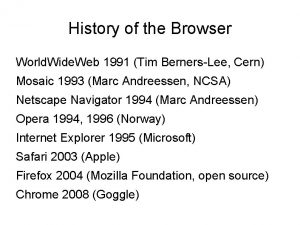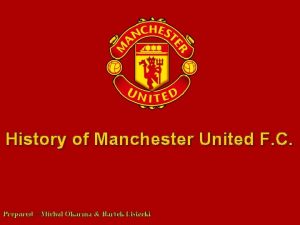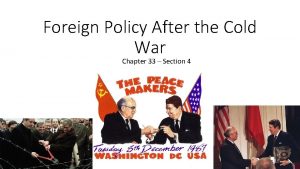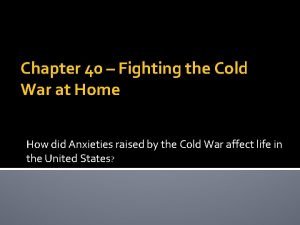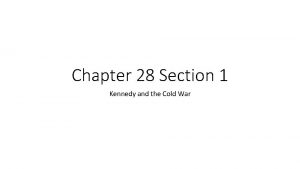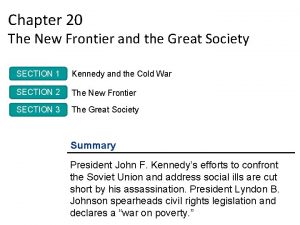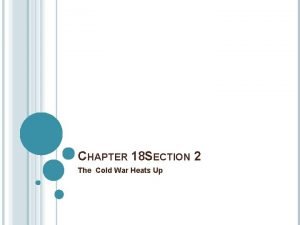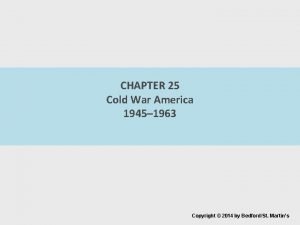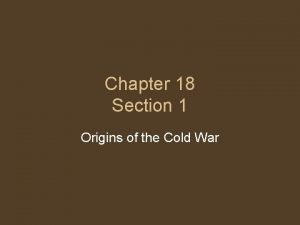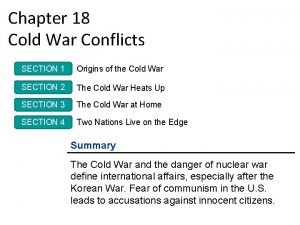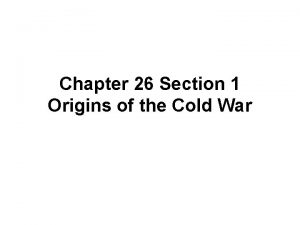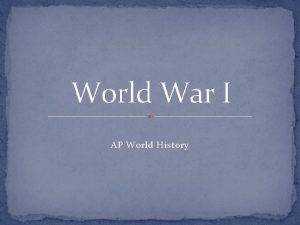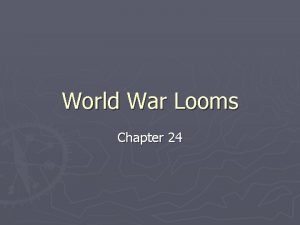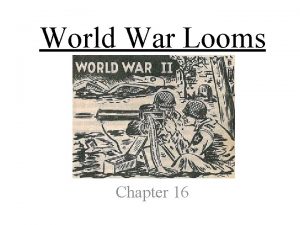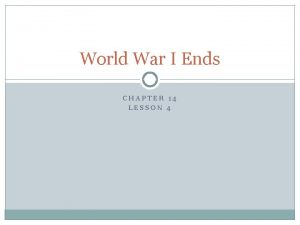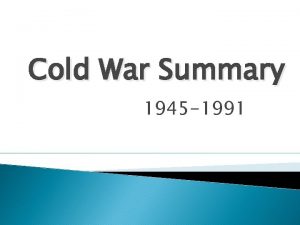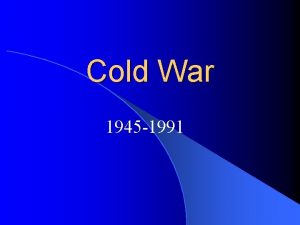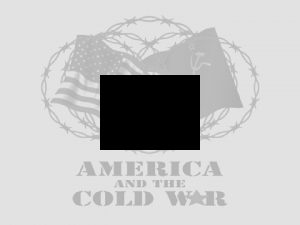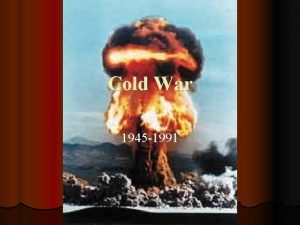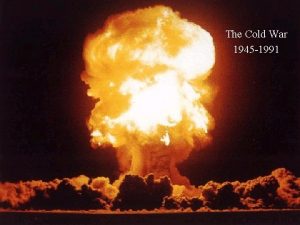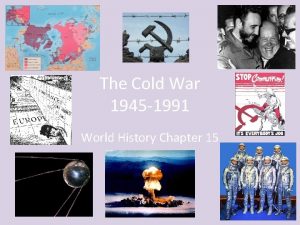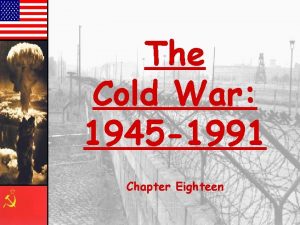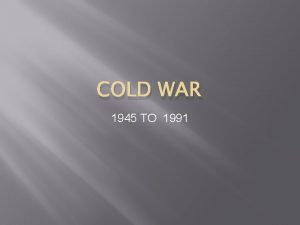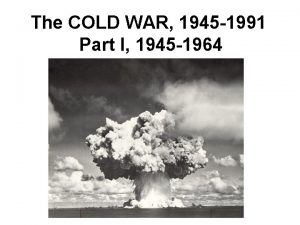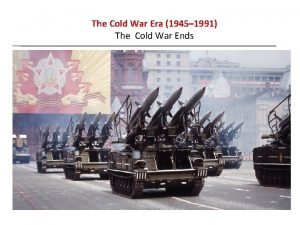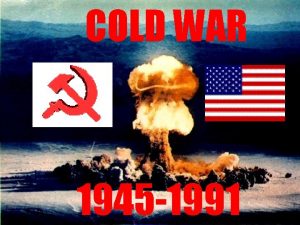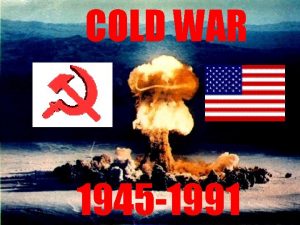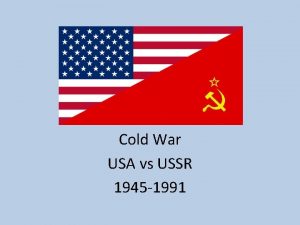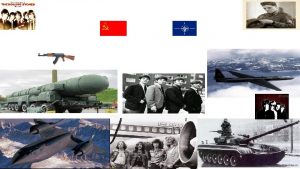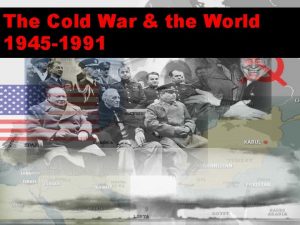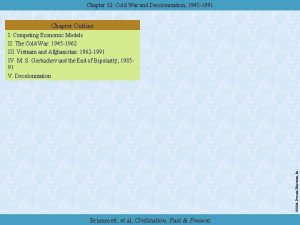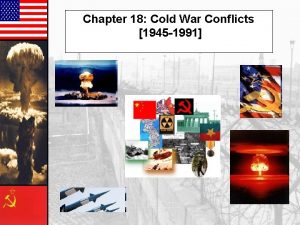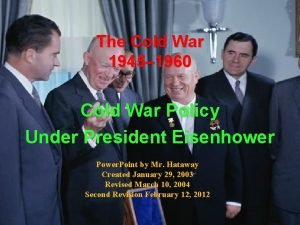The Cold War 1945 1991 World History Chapter




























- Slides: 28

The Cold War 1945 -1991 World History Chapter Review

Establishing the United Nations • • • In 1945, 50 nations gathered in San Francisco to draft a new charter for a United Nations to succeed the League of Nations, based on the last conference during the war at Yalta in 1945. The winning allies would have five permanent seats on the UN security council, each with the power of veto (U. S. , England, France, Soviet Union, China). The other seats on the security council would rotate among member nations. In the General Assembly, all nations would have equal voting power. The United Nations would take on issues such as peacekeeping, organizing prevention of disease, protecting refugees, helping nations develop economically, providing aid. Universal Declaration of Human Rights (Eleanor Roosevelt) 1948 – – • The Universal Declaration of Human Rights was the first international document to address in detail the notion that there exists a set of universal rights and fundamental freedoms that governments are obligated to secure for their citizens. The declaration describes justice, equality and dignity as basic human rights of every man, woman and child. According to the declaration, “all human beings are born free and equal in dignity and rights” and protecting the “inherent dignity of all members of the human family is the foundation of freedom, justice and peace in the world. ” The declaration became the foundation of international human-rights law. Bretton Woods Institutions – – World Bank International Monetary Fund

New Conflicts Develop • The Truman Doctrine – Helping countries oppose communism with economic and military aid • The Marshall Plan – To strengthen democracies and prevent the rise of new fascist states, the Marshall Plan offered massive amounts of food, grants of money, loans, materials, to countries harmed by the war, to help them rebuild their economies, provide jobs, and prevent uprisings. The plan worked magnificently, and former enemies became allies. – The Soviet Union refused aid, and refused aid for occupied countries. • Germany Stays Divided – To prevent Germany from becoming a threat again, the country was divided into four parts (US, British, French, Soviet zones) and Berlin was also divided the same way. • Western Germany under western control become democratic, and Eastern Germany became Communist.

The Berlin Airlift • Stalin’s resentment at the Marshal plan and the rebuilding of Western Germany erupted in the blockade of Berlin, which was surrounded by Eastern Germany. – Stalin believed that the West would fold rather than attack to open a path to the city. (Brinksmanship) – Instead, the West set up a round the clock airlift of supplies into West Berlin to feed the city that lasted more than a year. – At the height of the Airlift, one plane reached West Berlin every thirty seconds. Stalin backed down, but tensions rose. • The Propaganda War – Defending capitalism, freedom vs communism and totalitarianism – Defending the workers vs capitalist imperialist warmongers

The Cold War Unfolds • Two Sides Face Off in Europe • NATO • Warsaw Pact • Iron Curtain – A Wall Divides Berlin • West Berlin becomes a showcase for western prosperity, East Berlin stagnates under communism. TO stop people from fleeing to the west, a wall is built between East and West Berlin. – Eastern Europe Resists • During the 50’s and 60’, countries of Eastern Europe periodically resisted Soviet rule, but the Soviet Union was not afraid to use tanks on civilians.

Nuclear Weapons Threaten the World – Arms race between East and West – MAD – Hydrogen Bomb (1953) • Limiting Nuclear Weapons – – – 1963 Nuclear Test Ban Treaty (Atmospheric testing) 1972 SALT I (Freeze number of weapons) 1972 SALT I (Anti Ballistic Missile Treaty) 1979 SALT II (Limit number of weapons) 1991 START (Reductions) • Building Détente – Relaxation of tensions – Afghanistan problem • Stopping the Spread of Nuclear Weapons – In the 1960’s Britain, France, China build nuclear weapons – 1968 Nuclear Non-Proliferation Treaty

Nuclear Targets in US

• Ohio class Nuclear Ballistic Missile Submarine – 24 Trident II Missiles • 8 W 88 Nuclear MIRV Warhead (475 kt) • • • 192 Independent warheads, for a total of 91 mt (Megatons) of destructive firepower A megaton is equivalent to a million tons (or 2 billion pounds) of TNT Adding up all of the firepower used in WWII, including the atomic weapons used on Hiroshima and Nagasaki was roughly equal to 3 mt

The United States in the Cold War • Free Markets – The competition with the Soviet Union was not limited to military might, but extended to all aspects of government, philosophy, economics, and ideology. – The Space Race, Sputnik, Mercury Program, Gemini Program, Apollo Program • Containing the Soviet Union – Stopping communism at virtually any cost • Living With Nuclear Dangers – Fallout shelters – Crystal Palace, flying command centers, secret retreats, bombers, submarines, land based missiles, the football – Psychological testing, spies, Manchurian Candidates, • Seeking Enemies Within – FBI – House Un American Activities Committee (HUAC) and Mc. Carthy, going after Hollywood writers, questioning patriotism, the list

China in WWII • Even though the Nationalists and the Communists hated each other, they hated the Japanese more. • Though there was an uneasy truce between them, both groups continued to maneuver for support during the war. • Much of China was ravaged by the Japanese, and Chinese casualties were somewhere between 11 to 20 million. • The U. S. supported the Nationalists with money and arms, though much of this aid was not used against the Japanese, and ended up in the wealth of a few officers.

Communism Spreads in East Asia • Communists vs. Nationalists – The communists in China were mainly in the North West of the country, while the Nationalists were in the South West. – During WWII, the communists under Mao Zedong led guerilla campaigns against the Japanese. – They promoted literacy and increases in food production, and the peasants were very friendly with the communists • China’s Communist Revolution – How the Communists Won • The Nationalist economy collapsed • Peasants supported the communists • Nationalists under Jiang Jieshi fled to Formosa and renamed it Taiwan

Changing Chinese Society • The Great Leap Forward Fails • The Cultural Revolution Disrupts Life – Using the Soviet Union as a guide, Mao called for five year plans to improve the economy, private industries were taken over by the government – Like Stalin, Mao decided to collectivize workers and farms into communes. This Great Leap Forward actually went backward as crops failed and about 20 million starved – To Purify the country of dangerous elements and ideas, universities were shut down, intellectual and artistic work was considered useless and dangerous. – Hard work of the peasant was considered to be heroic. – Past ideas and old ways were dangerous and many were purged (killed) – The Cultural Revolution was worse than the Great Leap Forward, and somewhere between 18 and 45 million people were killed. By 1968, even Mao admitted it was a terrible failure and had it stopped.

China, The Cold War’s “Wild Card” • Split with the Soviet Union – Each side had it’s own idea of how communism should be understood. – Soviets began to fear Chinese expansion into Siberia (44 Soviet divisions on Chinese border, 31 Soviet divisions in Eastern Europe. ) • Taiwan and the Nationalists – The Nationalists under Jiang declared themselves a new country, but mainland China has never recognized the independence of Taiwan, and has declared many times that they will be reunited. – The U. S. supports Taiwan, and pledged defense

War Comes to Korea – A Divided Nation • North Korea: Soviet Union backed • South Korea: U. S. backed – North Korean Attack Brings a United Nations Response • North Korea – trying to reunite Korea under communism • Initial attack pushed defenders south to the Pusan pocket about 70 miles across • Gen Mac. Arthur landed a force behind NK lines at Inchon, forcing a retreat of the NK army • Use nuclear weapons? – Mac. Arthur sacked • Push to Yalu River – China Reverses United Nations Gains • 300, 000 Chinese attacked to help the North • Stalemate • 38 th Parallel – American in Korea • Helicopters • M*A*S*H • Two Koreas – South Korea Recovers – North Korea Digs In

War in Southeast Asia • Indochina After WWII • • French 1946 -1954 U. S. 1955 -1975 – Indochina Under Foreign Rule • • • French Colonialism from 1800 Japanese Invasion During WWII Return of the French after the War – Ho Chi Minh Fights the French • • Communist influence grows Vietnamese wanted independence, created Declaration based of the American Declaration of Independence, asked U. S. for help against the French want their colony back, fight insurgents Insurgents led by Ho Chi Minh conduct guerrilla war against the French, defeat French forces at the battle of Dienbienphu (dien bien foo) – Vietnam is Divided • • • After 1954, the struggle for Vietnam became a part of the Cold War. Western and Communist powers agreed to a separation of North and South Vietnam, the North being Communist, the South under (un-elected) leader Ngo Dihn Diem, supported by the U. S. Elections that might have reunited Vietnam were not held in the South, because the U. S. believed the Communists might win the election as not many South Vietnamese trusted the new government because of corruption. Diem’s dictatorship grew worse, and many South Vietnamese who regarded Ho Chi Minh (leader of the North) as a war hero (against the Japanese and the French), turned against the Diem government, and in the 1960’s, started a guerrilla campaign against the government, supported by communists in the North.

America Enters the Vietnam War – • Divided Vietnam – – • Ho Chi Minh (leader of the North) wanted to unite Vietnam under communism, and aided the National Liberation Front (NLF) also known as the Viet Cong, or VC, or Victor Charlie (based on the NATO phonetic alphabet) which is why they were often called “Charlie” by the troops. North Vietnamese troops were called Viet Minh (or North Vietnamese Army NVA) The U. S. at first sent supplies and advisors, but later sent hundreds of thousands of troops to support the corrupt Southern Vietnamese government. The Gulf of Tonkin – – • American foreign policy regarded the Vietnam War as a part of a larger conflict against Communism. Policy makers believed that if any country falls to communism, then it makes it more likely that the next country will fall, and so on, until communism takes over the U. S. This was called the Domino Theory. On 1 Aug 1964, South Vietnamese commandos raided North Vietnamese islands in the Gulf of Tonkin. A U. S. destroyer in the Gulf thought it was being attacked three days later, though this was likely an error in using their radar during rough seas. This was used as an excuse for the Gulf of Tonkin Resolution (7 Aug 64) authorizing President Lyndon Johnson to use all measures to support South Vietnam, and prevent further “aggression” in Southeast Asia. After the Gulf of Tonkin Resolution was passed, the U. S. started bombing targets in North Vietnam. War in Vietnam – – The North was not without superpower support, and Soviet weapons, ammo, fighter jets, missiles, tanks, and other equipment was given to the North. Jungle fighting Agent Orange Helicopter Gunships My Lai Massacre – – Napalm The Press – Body Counts – • Free fire zones

The War Intensifies • The Draft – – – • Guerrilla War – – – • During Vietnam, the U. S. military needed to use the draft to field the required number of troops (upwards of 500, 000). The draft at first had many exemptions that allowed college men, married men, men with children, or who had fathers with influence, to avoid the war. Some entered the National Guard to avoid being drafted, others joined “Champagne Units” such as the Texas Air National Guard, where most of the members were sons of rich and powerful men. As the war dragged on, the rules changed, exemptions were removed, and the draft became more democratic. Once this happened, and more middle class and upper class sons were drafted, the opposition to the war reached a fever pitch. The South Vietnamese rebels tended to be peasants, and familiar with the land, which neither the French nor the Americans could claim. Villagers often would hide rebels, or caches of weapons. The VC and the NVA built large tunnel complexes to avoid American bombing and surveillance. Getting from North to South was difficult for the VC and the NVA, so they used trails that crossed the borders of Cambodia and Laos, called the Ho Chi Minh Trail. American attacks on the Trail caused the conflict to widen, The Tet Offensive – – – By 1968, the South Vietnamese Army and the U. S. failed to suppress the insurgency, or prevent aid from the North, though the VC and the NVA could not make headway against the South’s defenses. The North Vietnamese decided to mount a major offensive, and attacked targets all across the country during the Vietnamese New Year, or Tet. This became known as the Tet Offensive. Though the North Vietnamese and the VC were driven back, the Offensive shook the confidence of Americans who thought the war was being won, and public opinion turned against the war.



The Vietnam War Ends – Casualties, KIA, MIA, as the numbers grew, American’s saw Vietnam as a quagmire. • More Americans Oppose the War – As the war dragged on, longer than WWII, Americans began to doubt whether the war could be won. Though most wanted to leave, should we ignore the sacrifices already made? – Massive protests – Kent State • America Withdraws – The Vietnam War destroyed the presidency of Lyndon Johnson, and he decided not to run for a second term. Lyndon’s successor, President Nixon, ended the war with North Vietnam at peace talks in Paris, January 1973. • North Vietnam Wins the War – After the Americans withdrew forces, the South tried to resist, but two years later, the North Vietnamese entered the capital Saigon, which would be renamed Ho Chi Minh City. – Many South Vietnamese panicked at the departure of American forces, and some were able to transported to the U. S. on navy ships, but most were left behind, a tragic reminder.




Southeast Asia After the War – After the fall of Vietnam to communists, the countries of Laos and Cambodia also fell under communist influence, but the dominoes stopped there, and other countries in Southeast Asia remained capitalistic. • Tragedy in Cambodia • Vietnam Under the Communists – During the Vietnam War, the U. S. bombed supply routes through Cambodia, and even invaded the country briefly, but this proved largely ineffective, and a local group of Cambodian communist guerrillas called the Khmer Rouge sprung up. – By 1975, the Khmer Rouge, under Pol Pot, had overthrown the government of Cambodia, and created a humanitarian disaster by killing over a third of it’s own population, over a million people. – The new Vietnamese government was not sympathetic to those who supported the Americans or the South Vietnamese government (even by default) and many fled the country by boat. – These “boat people” fled the country in the hundreds of thousands, landing in neighboring countries when allowed, and some made it to the U. S. , though many drowned in overcrowded boats. – Vietnam suffered for a long time, as a U. S. led embargo prevented many goods from entering the country, and poverty remained high for decades.

The Cold War Goes Global – China and Korea – Spread of Communism (Truman Doctrine) – Espionage • CIA and KGB – Propaganda – Non-aligned nations • Building Alliances and Bases • When the Cold War Goes Hot • Cuba Goes Communist • Cuban Missiles Spark a Crisis • Nicaragua and El Salvador (Proxy Wars) – Strategy to contain communism – NATO, SEATO, CENTO, Japan – Encircle Soviet Union – Local conflict became proxies for superpowers – Many former colonies gain independence – Fidel Castro, 1959, takes control of Cuba, institutes a communist regime. – Bay of Pigs – Trade Embargo – Soviet Union puts nuclear missiles in Cuba in response to American missiles in Turkey – Sandinistas – Contras

The Soviet Union in the Cold War • Soviet Communism – In the years that followed WWII (The Great Patriotic War), Stalin continued purging “enemies of the state” Somewhere around 20 million people disappeared, were sent to gulags, or were executed. • Stalin’s Successors Hold the Line – Nikita Khrushchev became premier after Stalin’s death in 1953. Openly denounced Stalin’s brutal regime in 1956, calling for peace with the west. – Leonid Brezhnev overthrew Khrushchev in 1963, and resumed Stalin’s tactics • Some Soviets Bravely Resist – Some Soviets tried to reform the system, including scientists and writers

The Middle East in the Cold War • Israel and Palestine – Arab-Israeli conflicts • Iran – Mossadegh, democratically elected leader deposed in coup by US and Britain in 1953, the Shah Pahlavi comes to power. – Terrible human rights record – Followers of Cleric Ayatollah Khomeini rose up and took the government, Americans in embassy captured 1979 – Hostage crisis • Carter and Reagan and election 1980 – Iran-Contra Affair

The End of the Cold War • The Soviet Union Declines – A Hollow Victory • What did the Soviet Union really accomplish, even with victory in WWII and a – Reforms Give Way to Repression • Though Stalinist pogroms were reduced under Khrushchev and Brezhnev, the – – eastern European sphere of influence? Soviet Union was still more than willing to use military force to keep European countries under their thumb. The Command Economy Stagnates • Though the Soviet Union was able to accomplish incredible things, their economy was not able to deliver to it’s citizens the benefits of a creative society. Cracking Under the Burden of Military Commitments • The massive military budgets of the U. S. and the Soviet Union during the cold • – Soviets Have Their Own “Vietnam” in Afghanistan • In 1979 the Soviet Union became involved in an internal conflict between • – – war fueled conflict around the world and maintained large fleets of ships, submarines, aircraft, and nuclear weapons. Though the Soviets did not spend as much as the U. S. in absolute terms, the Soviet military budget consumed a much larger portion of their total budget, and because of this, the Soviet Union literally could not spend enough to match U. S. military spending, and attempting to do so broke the Soviet economy. government and local warlords in Afghanistan. Soviet forces came in to support the government, but the warlords fought the redistribution of power. Also, religious fighters, or mujahedeen came to Afghanistan to fight to Soviets. Also, the CIA funded the anti-Soviet forces, as well as gave them weapons and logistical support. This is also where the U. S. recruited and trained Osama Bin Laden to fight the Soviets, and where he started his terrorist organization. Gorbachev Tries Reform • After Brezhnev, the Soviet Union went through a couple more old hard liners, but their time was ending. A new face of Soviet Politics had emerged, Mikhail Gorbachev tried valiantly to save the economy with reforms called Perestroika, and by reducing tensions with the west with openness, or Glasnost. An Empire Crumbles • While these reforms were needed, they also exposed the fundamental problems with the system, and the system fell apart. The Republics broke away and declared independence, and the government fell, bringing about a new Russian state.
 The cold war lesson 1 the cold war begins
The cold war lesson 1 the cold war begins The cold war begins 1945-1960
The cold war begins 1945-1960 The cold war heats up: 1945 - 1969
The cold war heats up: 1945 - 1969 Chapter 26 section 2 guided reading the cold war heats up
Chapter 26 section 2 guided reading the cold war heats up 1945 world war ii
1945 world war ii 1945 world war
1945 world war Proxy wars in the cold war
Proxy wars in the cold war History of cold war
History of cold war Ap world history chapter 25 africa and the atlantic world
Ap world history chapter 25 africa and the atlantic world World wide web 1991
World wide web 1991 History of manchester united f.c. (1945–1969)
History of manchester united f.c. (1945–1969) Chapter 33 section 4 foreign policy after the cold war
Chapter 33 section 4 foreign policy after the cold war Chapter 17 section 1 two superpowers face off answer key
Chapter 17 section 1 two superpowers face off answer key Chapter 40 fighting the cold war at home
Chapter 40 fighting the cold war at home Chapter 28 section 1 kennedy and the cold war
Chapter 28 section 1 kennedy and the cold war Chapter 20 section 1 kennedy and the cold war
Chapter 20 section 1 kennedy and the cold war Chapter 18 section 2 guided reading the cold war heats up
Chapter 18 section 2 guided reading the cold war heats up Chapter 25 cold war america
Chapter 25 cold war america Origins of the cold war chapter 18 section 1
Origins of the cold war chapter 18 section 1 Origins of the cold war chapter 18 section 1
Origins of the cold war chapter 18 section 1 Chapter 26 section 1 origins of the cold war
Chapter 26 section 1 origins of the cold war Total war world history definition
Total war world history definition Chapter 30 the war to end war
Chapter 30 the war to end war Chapter 30 the war to end war
Chapter 30 the war to end war Countries michael jackson visited
Countries michael jackson visited Chapter 24 world war looms
Chapter 24 world war looms Chapter 16 building vocabulary world war looms
Chapter 16 building vocabulary world war looms World war 1 and the russian revolution chapter 27
World war 1 and the russian revolution chapter 27 Chapter 27 lesson 4 world war 1 ends
Chapter 27 lesson 4 world war 1 ends

